Back movement and muscle contractions
We are no longer building saddle trees, but we have two videos about how Western saddles fit horses available on our westernsaddlefit.com website.
We finished off the previous post in this series by saying "So if we just went with how things look like they should work, then the longissimus dorsi, the serratus dorsalis, the iliocostalis and the multifidus should be contracting as the back extends, and the sublumbar muscles and the abdominal muscles, including the rectus abdominis, should be contracting when the back is flexing." But is this really so? Well, here's what fancy technology has discovered...
Why they study the trot the most
Most studies on back movement, muscle activation, etc. have been done at the trot. Why? It is a totally symmetrical gait and is the least complicated of the gaits. Therefore, it is the gait that gets chosen to test new technology, try out new testing procedures, etc. And if things work at the trot, then they start looking at the walk and maybe, eventually, at the canter. (I say canter rather than lope because almost all of this work comes from the "English" riding world, and that is their terminology. I don't recall ever seeing the term "lope" in the technical literature.)
How they test these things
There are studies which have checked out the actual flexion/extension/lateral bending/axial rotation motions of the spine - basically trying to figure out the movement of the total spine by testing the movement of certain vertebrae and comparing them to each other. (One very fancy set of tests even did the canter!) And there are a few studies where they used electromyography (EMG) to check out muscle activity. To do this, they put recording electrodes on the skin of the horse in specific places to read the electrical impulses of the longissimus dorsi and, in one case, the rectus abdominis. Then they had to do all sorts of fancy procedures with the readings to remove extraneous "noise" from the data - readings coming from skin, other muscles, heartbeat, etc. When I read those paragraphs, I know that's why they are the researchers and I'm not... So there are different ways to learn what they want to know.
So what did they find about the trot?
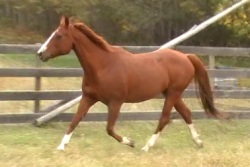 |
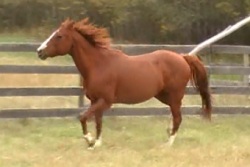 |
Basically, from the time the diagonal feet hit to approximately mid-stance (when the grounded legs are vertical) the back is extending. (1)
 |
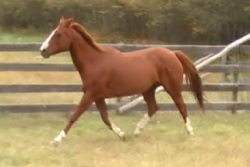 |
From approximately mid-stance to take off and during the suspension phase, the back is flexing. (1) This happens twice during each stride of the trot as both diagonals do the same thing.
But it's a flow...
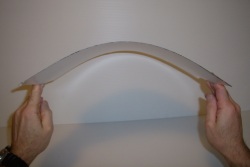 |
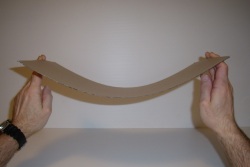 |
Remember, however, that this doesn't happen all at once, like the cardboard in these pictures. The tests that checked the movement of individual vertebrae and compared them to each other gave us the information that the back doesn't flex and extend as a unit, but that there is a "flow" of movement along the back, both up and down (dorsoventrally) and side to side (laterally). (I mentioned this briefly in a previous post in March. You'll recognize the pictures...)
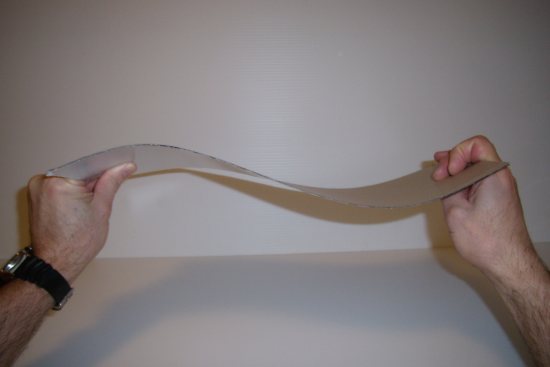
The flow is not as exaggerated as these pictures show, but it is a flow none the less. The "flow" idea goes for lateral flexion too.
EMG study results
So now that we have the basic picture of how the back extends and flexes at the trot, what about the EMG studies? First, there was a study that tested the longissimus dorsi and the rectus abdominis at the same time to see when during the stride these muscles were active. (2) In this test, they only measured one side, with one electrode registering the electrical activity in only one place along the longissimus dorsi (next to L3), and another electrode positioned to the side of the umbilicus checking out the rectus abdominis.
They also had a camera set up to confirm the movement of the back as discovered in previous studies (it did) and, in addition, to see what effect changing the speed of the trot had on these factors. (For the record, as the speed increased, the range of motion of the back decreased. There was less flexion and extension for each stride as the horse trotted faster. Makes sense.)
So what did they find?
For every full stride, each muscle showed two, non-identical bursts of electrical activity. So each muscle would have been contracting twice, which makes sense because the back flexes and extends twice during a full stride. (The activity of the longissimus dorsi was higher when the hind leg on the same side was in stance phase and less when the hind leg on the other side was stance phase, though it still fired during that phase of the stride.)
Remember, from the time of contact to the time of mid-stance, the back was extending. Which muscle will cause extension when it contracts bilaterally? The longissimus dorsi. Right. So which muscle actually was active when the back was extending? The rectus abdominis!!! Really...
And from the time of mid-stance to suspension, the back was flexing. Which muscle will cause flexion when it contracts bilaterally? The rectus abdominis. Right again. And which muscle actually was active when the back was flexing? The longissimus dorsi!!!
HUH????
Once again, just like when we learned that horses sometimes breathe out when their chest is expanding, the ideas we have of how things have to work based on how they look is incorrect, because things are much more complicated in real life than they look like they should be. (Which is why evolution is untenable as a theory. Read Darwin's Black Box for more information about that...)
So what is really happening?
The conclusion these and other researchers have come to is that these muscles, which can and do induce the back movements we expect when they are stimulated to contract bilaterally, don't actually work that way during normal movements of the horse. It isn't really the activity of these muscles which causes the back to flex and extend. It is a lot of other factors.
And what are those factors?
One paper (1) suggests that "the back extension may be attributed to the accelerations applied to the mass of abdominal viscera. This extension force is counterbalanced by the activity of the rectus abdominis muscle. In this way, this muscle supports the abdominal viscera and limits the back extension." Remember how the gut sloshes front and back in the abdomen at the canter and gallop, putting pressure on the diaphragm and affecting the breathing? Well, it also has weight and will move up and down, especially at the more pounding gait of the trot compared to the walk. So the legs hit and stop the main skeleton from going down too fast, but the gut, surrounded and held up by the abdominal muscles, keeps heading towards the ground. This causes the back to extend, but that movement is limited by the abdominal muscles, especially the rectus abdominis.
They go on to say, "the back flexion may be attributed in part to the changes in the trunk accelerations and to the release of elastic energy stored within the intervertebral ligaments and fibrous tissues of the abdominal wall which have been stretched in the extension movement. This flexion movement is now counterbalanced by the activity of the longissimus muscle." In other words, when things pull down, they cause stretching of a lot of tissues. When the force downwards is decreased, all these stretched fibres want to go back to their normal state, and the longissimus dorsi is what stops everything from over-flexing.
Another paper (3) states, "The propagation of a wave of flexion-extension along the spine depends on the forces acting on the spine... The forces include gravitational, inertial, muscle forces (from many muscles), forces from passive skeletal tissues and forces transmitted from the front and hind limbs." This agrees with other reading I have done (4) which shows that the movement of the legs is a huge factor in causing the back movements we see at different gaits. For instance, the hind leg stretching forward tilts the pelvis and causes flexion of the lumbosacral joint and, depending on the gait, affects flexion in the caudal part of the back too. And the longissimus dorsi acts to stop over-flexion as a result of all these forces.
So basically, the back moves because all sorts of things act on it to flex, extend, twist and turn it. And the muscles we are discussing actually spend a lot of time limiting the amount of back movement. One study (5) concluded that "activity of the longissimus dorsi muscles is mainly responsible for stabilization of the vertebral column against dynamic forces." Said in another way, they "stiffen" the back.
OK, but we don't want a "stiff" back, do we?
Don't we want the back to be flexible and mobile? Absolutely yes, but if we let the back go to the extremes it would without that "stiffening" influence, it would hyper-extend and hyper-flex, resulting in damage to ligaments, bones, etc. "All things in moderation." So while we don't want any muscles to be constantly contracted (anyone with a stiff neck knows what that feels like) we do want them to be alternately contracting and relaxing - in other words, working normally, the way they were intended to work.
Paper #3 goes on to say "The elasticity and stiffness are a combination of passive components from the spinal column (note: this would be tendons and ligaments primarily) and active components provided by the muscles contracting around the spine." Just because researchers can't measure the multifidus, psoas major and minor and all the other muscles we talked about (they are too deep in the body to easily access) doesn't mean they aren't active too.
Testing the longissimus dorsi in multiple places
Other studies (3, 5) have checked out the EMG of the longissimus dorsi in a few places down the spine. The longissimus is a segmented muscle, and the segments are not all connected to the same nerve. Therefore, they can contract at different times. But do they?
Yup. One study (5) tested the EMG at three different places along the longissimus dorsi - beside T12, T16, and L3. They found that at the trot, "the EMG activity peaked slightly later at L3 than at T12 and T16." However, another study (3) didn't find this same correlation, which might be due to the different stats used. (I don't understand much of that part of the papers - yet...) But they did find definite differences in timing between electrodes placed beside T14, T16, T18 and L2. So there is no question that the segments of the longissimus dorsi contract at different times during the stride. And this fits with the idea that the movements of the spine are a flow.
What about lateral flexion?
A couple of studies also checked out the lateral bending motion and how it correlates to the EMG results from the longissimus dorsi, but their comments come more from the tests done at the walk. One study (6) noted "maximum EMG activity occurs during the early part of the maximum lateral excursion of the spine, which can be interpreted as pre-emptive tension." In other words, the longissimus dorsi acts to "stiffen" the spine laterally as well as during flexion/extension. Another study (3) concluded "the longissimus dorsi has a greater role in generating lateral bending movement for the less demanding walking conditions."
That study also commented "the role of the longissimus dorsi for generating lateral bending moments is more dominant at the more cranial recording sites, and this is a general result across the range of walking and trotting conditions tested." So not only is there a time shift in when different segments of the muscle contract, but they can also have different effects on the spine - some more cranial sections seeming to affect lateral bending more and some more caudal sections affecting flexion/extension more. They suggest that this is probably based on the angles at which the muscle fibres are arranged and how they are attached to the vertebrae, but that hasn't been totally documented yet.
Conclusions
1.) The muscles we might think would act to make the spine move, actually work most of the time to dampen excessive spinal movement caused by other factors. The longissimus dorsi and rectus abdominis are active at phases in the stride opposite to what we might expect.
2.) The longissimus dorsi is a segmented muscle and doesn't act as all at one time. Different segments at different levels of the spine contract at different times and seem to have different effects in terms of the amount of lateral bending versus flexion/extension. The conclusion in one study (3) was "the mechanical function of the longissimus dorsi should not be considered as a general property that is applicable to the whole muscle, but instead varies between segments, between locomotor conditions and is under the control of the central nervous system."
3.) Different gaits, speeds, amount of incline, etc. all affect when and how much activity exists in the longissimus dorsi and the rectus abdominis. It just ain't real simple!! And that is the truth about all biological systems. They are WAY more complicated in how they act than in how they first appear. We just know the tip of the iceberg of what there is to discover.
That's all folks!!
And this post brings us to the end of the series on anatomy and biomechanics that I started back in September of 2011. The posts are all linked (all 31 of them!) so you can go through and read all of them if you want.
References:
(1) Kinematics of the equine back: flexion-extension movements in sound trotting horses. F. Audigie, P. Pourcelot, C. Degueurce, J.M. Denoix, D. Geiger, Equine Exercise Physiology 5 Equine Veterinary Journal Supplement 30 (1999) 210 - 213.
(2) Effects of treadmill speed on the mechanics of the back in the trotting horse. C. Robert, F. Audigie, J.P. Valette, P. Pourcelot, J.M. Denoix Equine Veterinary Journal Supplement 33 (2001) 154-159
(3) Segmental variation in the activity and function of the euqine longissimus dorsi muscle during walk and trot. James M Wakeling, Pattama Ritruechai, Sarah Dalton, Kathryn Nankervis, Equine and comparative Exercise Physiology 4(2); 95-103 (2007)
(4) Treadmill study of the range of back movement at the walk in horses without back pain. Theresia F. Licka, Christian Peham, Elisabeth Zohmann American Journal of Veterinary Research, Vol 62, No. 7, July 2001
(5) Electromyographic activity of the longissimus dorsi muscles in horses during trotting on a treadmill. Theresia F. Licka, Christian Peham, Alexander Frey, American Journal of Veterinary Research vol 65 No. 2 February 2004
(6) Electromyographic activity of the longissimus dorsi muscles in horses when walking on a treadmill T. Licka, A. Frey, C. Peham, The Veterinary Journal 180 (2009) 71-76
stumbled upon your series by luck - and what luck that was. Thank you thoughtful, well written and referenced.
Posted by RodandDenise
Thank you for your kind words.
